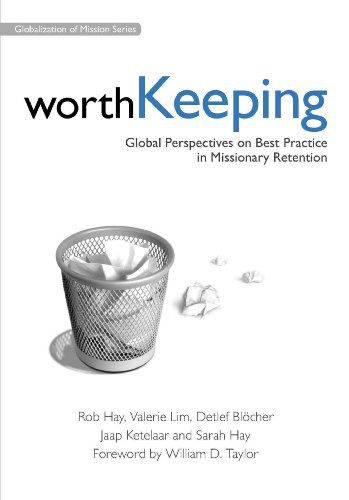
I’ve known Tabor Laughlin for a long time. With unquestioned character and competence, he is an exceptional cross-cultural worker. For this reason, I was overjoyed to hear that Tabor finished his dissertation, “Factors Impacting Cultural Adjustment and Retention of Chinese Cross-Cultural Workers.” In it, he explores various factors influencing the cultural adjustment and retention of Chinese missionaries.
By the way, it will soon be published by Wipf & Stock as a part of the EMS Dissertation series.
Four Key Conclusions
Twelve major themes emerged from his research and interviews with Chinese workers. However, in this post, I will only highlight what Laughlin calls the “four key conclusions” of his study. While his findings are compelling, I will take issue with the analysis that leads to one of his conclusions.
-
Finances are a significant challenge for Chinese missionaries.
Many Chinese missionaries receive financial support from sending house churches. All too often, this funding is insufficient and/or inconsistent. Financial stress takes a toll on marriages. Several missionaries spoke of not having the support needed to pay for their children’s’ education. Another dire threat looms over them as well. Inadequate funding could prevent them from returning to China, being unable to afford the expense.
-
The need for pre-field vocational training.
Laughlin adds,
A recurring theme throughout the interviews was peoples’ lack of preparation in the area of vocational skills that would have enabled them to obtain a long-term visa and earn an income on the mission field. (p. 130)
Vocational skills can certainly contribute to the need for financial stability. Furthermore, without such training, the missionary can only maintain a student visa or a tourist visa. Both options are short-term. Also, people from a missionary’s host culture will grow suspicious of the Chinese worker’s motive for being in the country.
-
The impact of filial piety on Chinese missionaries.
Even into adulthood, Chinese children feel a strong sense of obligation to take care of their parents and honor their families. Therefore, it is no surprise that…
…it can be shameful for Chinese missionaries when they move to the mission field if they are perceived as abandoning their aging parents in China and failing to live up to their society’s standards of filial piety. (p 132)
In Chinese society, elderly people rely heavily on the support of their child(ren). They do not enjoy a governmental safety net akin to Social Security in the States.
On the other hand, many Chinese families do not approve of their children serving as missionaries. Such work does not give them “face” or wealth. In short, “Lack of family support of their moving to the mission field can hinder such people from becoming missionaries, or force them to prematurely leave the mission field” (p. 134).
-
No correlation between educational achievement and cross-cultural effectiveness.
Laughlin’s final “key conclusion” deserves closer attention. His analysis is problematic, and his summary remarks could inadvertently mislead readers. I will first quote Laughlin before making comments. He says,
The fourth emerging theme from the research is that there is no correlation between educational achievement and cross-cultural effectiveness. Of the 25 Chinese missionaries interviewed, eleven had no more than a middle or high school education. From this research, and from my personal judgment and evaluation of the missionaries through the interviews, no clear distinction in effective cross-cultural adjustment was identifiable on the field for those with more formal school education compared to those with less. Many with only a middle school education seemed to flourish in learning the host language and building cross-cultural relationships, while some who had bachelor’s degrees did not adjust as well in cross-cultural ministry.
These findings are contrary to Rob Hay’s description that high retaining mission agencies have twice as many missionaries with master’s or doctoral degrees.
Several points deserve a closer look and a response.
Taking a Closer Look
First of all, Laughlin slightly alters his wording in this section, which could unwittingly cause readers to draw a wrong conclusion. He first speaks of the relationship between the missionary’s level of education and his “cross-cultural effectiveness.”
What does he mean by “cross-cultural effectiveness”? The phrase by itself is ambiguous. What are the criteria for being an “effective” cross-cultural missionary? Upon closer reading, what Laughlin means is “effective cross-cultural adjustment.” It is critical for readers to note this more explicit phrasing, lest one draw wrong conclusions from Laughlin’s research.
Also important is the contrast Laughlin makes between his findings and the work of Rob Hay. When one actually reads the cited passage from Hay’s Worth Keeping, it seems that Laughlin compares grapes with raisins, if not apples and bananas. Sure, there might be some relationship between the two studies; however, the relationship appears thinner than Laughlin supposes.
First, Hay assesses retention rates. He explains,
In simple terms, education is very helpful in retaining missionaries. High retaining agencies have almost twice as many missionaries with MA degrees and doctorates. They also have, on average, expected 2-3 times as much formal missiological training plus 50% more practical pre-field missionary training [compared with low retaining agencies]. Highly educated personnel can be more easily retained, since they have more potential to be offered and successfully fulfil different assignments within the same agency.
In substance, Laughlin makes a far narrower claim than Hay. In short, Laughlin says, “Many of both the more educated and less educated interviewees seemed to flourish cross-culturally in learning well the host language and effectively making close relationships with hosts” (p. 154). Hay does not contest this specific point.
Hay addresses a broader issue than does Laughlin. Whereas Hay highlights the correlation between retaining missionaries and higher levels of education, Laughlin describes only one of several factors that influence Chinese missionary retention rates (i.e., cultural adaptation).
Besides the factors mentioned above, other influences include:
- language learning
- missionary preparation
- building intimate relationships with hosts
- the missionary’s team
- the level of supportiveness of mission agencies
- unique challenges for single missionaries
- overcoming hosts’ stereotypes and prejudices of Chinese
In fact, successfully adapting to a cross-cultural environment is only one component contributing to the retention of Chinese missionaries.
In fact, having more than a middle-school or high-school education would significantly help missionaries address the problems of finances and of securing a long-term visa (hence the need for pre-field training).
Furthermore, Laughlin later makes an important comment concerning the 11 missionaries who “had no more than a middle or high school education.” He says,
Although these missionaries have a low level of formal school education, they may have received extensive theological education or mission training. (p. 153)
Thus, even these missionaries received training that likely contributed significantly to their ability to adapt to their host culture, even if such training does not yield a “formal” degree.
Aside from my quibble above, I think Laughlin has made an important contribution to the missionary task. He sheds light on a group of people with whom few have access. The dissertation is full of interesting and thoughtful quotations from Chinese workers.
To be sure, it is a dissertation. So, for those who want to jump to the meaty parts, you can use the table of contents and the search-function on your PDF reader (The link has been removed because it has been selected for publication in the EMS Dissertation series). I hope churches and mission agencies give it a serious look and discuss its implications.












